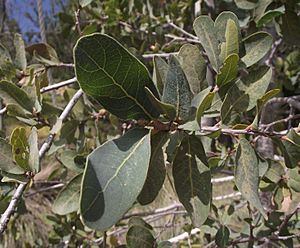Engelmann oak facts for kids
Quick facts for kids Engelmann oak |
|
|---|---|
 |
|
 |
|
| Conservation status | |
| Scientific classification | |
| Genus: |
Quercus
|
| Species: |
engelmannii
|
 |
|
| Natural US range of Quercus engelmannii | |
The Engelmann oak, also called the Pasadena oak, is a special kind of oak tree. Its scientific name is Quercus engelmannii. It belongs to the group of "white oaks." You can find these trees growing naturally in southern California and northwestern Baja California, Mexico.
Contents
What the Engelmann Oak Looks Like
The Engelmann oak is usually a small tree. It can grow up to about 33 feet (10 meters) tall. Most of the time, it keeps its leaves all year round, which means it's an evergreen tree. However, if the summer is very hot and dry, it might drop its leaves to save water. This is called being "drought-deciduous." The tree often has a round or oval shape.
Its bark is thick and has deep grooves, and it's usually light gray-brown. The leaves feel tough, like leather. They are about 1 to 2.5 inches (3 to 6 cm) long and 0.5 to 1 inch (1 to 2 cm) wide. They have a pretty blue-green color and can be flat or slightly wavy along their edges.
The flowers of the Engelmann oak are called catkins. The fruit is an acorn, which is about 0.5 to 1 inch (1.5 to 2.5 cm) long. These acorns take about 6 to 8 months to fully grow after the flowers are pollinated.
The wood of this tree is dark brown and very strong. However, it can twist and crack when it dries, so it's not often used for timber.
Where Engelmann Oaks Grow
The Engelmann oak grows in a specific area, mostly in southern California and northern Mexico.
Natural Habitat
You can find these trees in the foothills of the San Gabriel Mountains in eastern Los Angeles County. They also grow through the Santa Ana Mountains in Orange County. Further south, they are found in the western foothills and flat areas of the Peninsular Ranges in Riverside and San Diego counties. Their range extends into the Sierra de Juárez and Sierra de San Pedro Mártir mountains in northern Baja California, Mexico.
These oaks usually live in savannas (grassy areas with scattered trees) and woodlands. They prefer areas above the dry coastal plains but below about 4,265 feet (1,300 meters) in elevation, where winters get too cold for them.
Changes to Their Range
The Engelmann oak has a smaller natural range compared to many other California oaks. Sadly, city growth has removed many of these trees from the northern parts of their original home, especially in the San Gabriel Valley.
The biggest groups of Engelmann oaks still growing today are on the Santa Rosa Plateau, near Murrieta in Riverside County. You can also find many on Black Mountain near Ramona in San Diego County.
Ancient History of the Oak
Scientists have found fossils that show Engelmann oaks once grew in a much larger area. They used to live across what are now the Mojave and Sonoran deserts, reaching into eastern California and Arizona.
The Engelmann oak is closely related to the Arizona white oak and the Arizona blue oak. These relatives grow in the warmer, subtropical pine-oak woodlands of Arizona and northern Mexico. The Engelmann oak is thought to be the northernmost type of subtropical oak. It became separated from its relatives to the east when the southwestern deserts became very dry.
See also
 In Spanish: Quercus engelmannii para niños
In Spanish: Quercus engelmannii para niños


